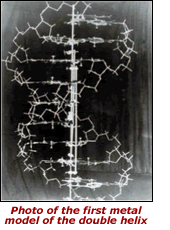Last updated: April 23, 2013
1953: DNA Double Helix
1953: DNA Double Helix
 Francis Crick and James Watson described the double helix structure of DNA. By the time Watson and Crick turned their attention to solving the chemical structure of DNA, DNA was known to have the following attributes:
Francis Crick and James Watson described the double helix structure of DNA. By the time Watson and Crick turned their attention to solving the chemical structure of DNA, DNA was known to have the following attributes:
- DNA is made of nucleotides, chemical building blocks made of three parts: a phosphate group that is linked to a deoxyribose sugar, which is in turn linked to one of four nitrogenous bases - adenine (A), cytosine (C), guanine (G), or thymine (T). Nucleotides are linked in series into a chain, with phosphate and sugar groups alternating. Phoebus Levene had determined these chemical characteristics.
- In the DNA of any given type of cell, the amount of adenine approximately equals the amount of thymine, while the amount of cytosine approximately equals the amount of guanine. Erwin Chargaff had shown this in 1949.
- X-ray diffraction patterns, obtained by Rosalind Franklin and Maurice Wilkins, revealed great symmetry and consistency in the structure of DNA and gave important clues about its dimensions.
Watson and Crick raced to find the structure before anyone else. They were competing with Linus Pauling, who had earlier discovered the alpha-helical structure of some protein molecules. While Watson and Crick were still working on their model, Pauling published a paper suggesting a triple-helical structure for DNA. Others quickly realized that the model was chemically flawed. Watson and Crick used paper cutouts of the bases and metal scraps from a machine shop to come up with their own model.
Their model revealed the following important properties:
- DNA is a double helix, with the sugar and phosphate parts of nucleotides forming the two strands of the helix, and the nucleotide bases pointing into the helix and stacking on top of each other.
- The nucleotide bases use hydrogen bonds to pair specifically, with an A always opposing a T, and a C always opposing a G.
- The two strands of the double helix run in opposite directions.
Their 900-word paper, published in Nature, concluded, famously, "It has not escaped our notice that the specific pairing we have postulated immediately suggests a possible copying mechanism for the genetic material."
Reproduced paper ![]()
Published in Nature
April 25, 1953
To view the PDF on this page, you will need Adobe Reader. ![]()
Watson, Crick and Wilkins received the Nobel Prize for Physiology or Medicine in 1962.
More Information
Reference:
James Watson wrote a personal account of his famous discovery and the people involved: James D. Watson, "The Double Helix: A Personal Account of the Discovery of the Structure of DNA". The book, originally published in 1968, has been republished several times.
 |  |
« Previous Event | Next Event »
